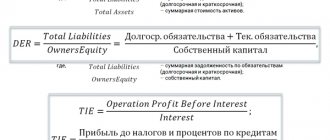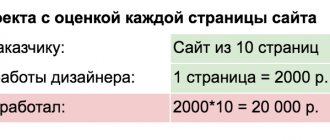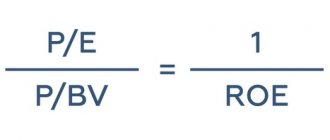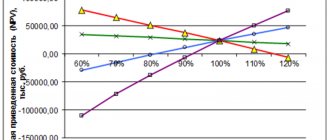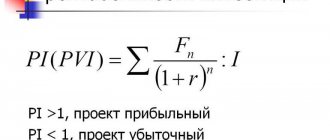Criterion for evaluating investment investments
The form of implementation of a company's investment activity is an investment project. When evaluating it, it is necessary to determine its economic efficiency. One of the criteria for evaluating investment investments is the standard investment efficiency ratio. But where to find funds in time for investment when there is a crisis in the economy and instability in legislation? Most investors are located abroad, where financiers play by their own rules; they are ready to invest only in those projects that will bring them benefits. The problem arises: what can attract the attention of foreign investors? What can serve as the starting point that will raise the flag to start investing?
Often decisions must be made when many alternative projects exist. In this case, it is necessary to select one or more options based on certain criteria. Investors need to make an economic justification for investments, therefore, in our opinion, such a point can serve as a standard investment efficiency ratio, which will show the attractiveness and feasibility of attracting them to a particular industry. It is this parameter that shows the optimization of the specified volume of production of the final product. Therefore, the purpose of the study is to study how the standard coefficient of efficiency of investment use evolves in modern conditions.
Efficiency of use of production factors
Any enterprise has labor resources, fixed and working capital. Without them, the production process is impossible. Companies are also trying to improve their investment performance to improve performance.
To calculate the efficiency of using each of these factors, different methods are used. Some of them are based on the same principles.
Research and publications on the problem
World scientific thought presents many theoretical developments on methods and criteria for assessing the economic efficiency of investments. Well-known foreign researchers in this field are: V. Behrens, L. J. Gitman, M. D. Jonki, P. M. Havranek, V. Sharp, I. Ansof, S. Schmidt, J. Francis, J. Van Horn , D. Markowitz, H. Johnson, J. Bailey, G. Alexander. Scientific works of leading scientists from the CIS countries are devoted to the study of various aspects of investment activity and analysis of the effectiveness of investment projects. These are V. I. Anin, V. P. Babich, Y. Bazhal, I. A. Blank, L. M. Borshch, Y. Bendersky, A. Galchinsky, V. Geets, A. Goiko, K. A. Efimov , V. Krasovsky, D. S. Lvov, M. Melnik, A. S. Muzychenko, E. Panchenko and others.
Presentation of the main material
When evaluating an investment project, it is necessary to determine its economic efficiency. One of these investment evaluation criteria is the standard investment efficiency ratio. What is it? What is it used for and is there a need for it at all in modern conditions? The concept of “standard investment efficiency ratio” arose back in Soviet times, when this ratio was established in a planned and directive manner by the highest branches of government. Its necessity was caused by the fact that both enterprises and industries, and the state needed an indicator that would force everyone to try to achieve, and sometimes even exaggerate, the specified indicator, thereby showing the high efficiency of the enterprise, industry, and country. Therefore, the first manifestations were reflected in the Methodological Recommendations of the USSR State Committee for Science and Technology, in the State Planning Committee, etc.
Main directions for increasing efficiency
The key to successful management of any enterprise (industrial or public catering) is the constant improvement of production efficiency, namely, systematic analysis and evaluation of the effectiveness of working capital used, planning, development and implementation of measures to improve efficiency. The main direction of increasing the efficiency of an enterprise is considered to be improving product quality.
Improving product quality contributes to:
- an increase in sales volume, and therefore profit;
- product competitiveness;
- improving the image of the enterprise;
- reducing the risk of bankruptcy and ensuring a stable financial position.
Improving quality is not the only way to improve efficiency. To improve the overall financial and economic condition of the organization it is necessary:
- Reduce labor intensity
- Save labor resources.
- Increase the technical level of production.
- Introduce financial incentive systems.
- Master new technologies.
- Automate and mechanize production.
- Create and use new types of materials.
- Increase the professional level of staff.
- Improve working conditions.
- Improve the motivation system.
One of the main economic management methods that ensure the effective functioning of an enterprise is marketing. Marketing allows you to study the needs of customers and find ways to quickly and profitably satisfy these needs with minimal risks and costs, but with maximum potential profit.
Determination of the standard coefficient
The standard coefficient is the minimum acceptable level of economic return from the inclusion of an additional unit of resource in economic circulation. In its economic essence, the standard efficiency coefficient shows the overall result of optimizing the distribution of free capital investment resources, which ensures the maximum reduction in current costs, the mathematical formulation of which boils down to the following.
First of all, the standard coefficient of economic efficiency comes from the problem of minimizing the total current costs of producing a quantity of products fixed by the plan. The resulting value will be optimal. In Soviet times, these parameters could be calculated for each enterprise, for an industry, and for the country as a whole. Standard investment efficiency ratios are used only to compare investment growth when justifying the most rational option. They cannot be identified with the standard when determining the absolute efficiency of capital investments. The standard cost-effectiveness ratio is an integral part of the levelized cost methodology. It is based on a criterion that is calculated using formula (1). The option with the minimum amount of total costs is also considered effective: Зі = Сi + EnKi → min, (1), where:
Zi — costs for each option;
Сi — current costs for each option;
En is the standard investment efficiency ratio;
Ki is the capital investment for each option.
Therefore, the economic efficiency of capital investments is compared according to the level of reduced costs for several investment options. The most efficient use of capital investment is the one that provides the minimum amount of present costs per unit of product or work performed. However, already in the next Methodology (1977), the standard investment efficiency coefficient is used as the only one and is set at 0.15. In modern conditions, it is equal to the discount rate (bringing economic indicators at different times to the beginning of the billing period - that is, up to the year preceding the start of construction), the value of which is accepted depending on specific conditions (usually corresponds to the discount interest rate of the National Bank). In market conditions, it is better to select investment project options based on the compromise criterion of net profit, since this largely balances current expenses and future income from investments made. On the other hand, this criterion has the disadvantage that, according to it, objects are selected without sufficient consideration of the needs of scientific and technological progress, so it slows down.
IRR calculation
IRR, Internal Rate of Return
The internal rate of return indicator or internal rate of return is calculated on the basis of the NPV indicator; this coefficient shows the maximum cost of investment, indicates the maximum permissible relative level of expenses that can be associated with a given project.
For example, if a project is financed entirely by a loan from a commercial bank, then the IRR value shows the upper limit of the acceptable level of the bank interest rate, above which the project will be unprofitable.
The economic meaning of this indicator is as follows: an enterprise can make any investment decisions, the level of profitability of which is not lower than the current value of the price of the source of funds for this project (English, Cost of Capital, CC). It is with this that the IRR calculated for a specific project is compared, and the relationship between them is as follows:
- if IRR > СС the project should be accepted;
- if IRR < СС the project should be rejected;
- at IRR = СС the project is neither profitable nor unprofitable.
Another interpretation option is to treat the internal rate of return as a possible discount rate at which the project is still profitable according to the NPV criterion. The decision is made based on comparison of IRR with standard profitability; Moreover, the higher the internal rate of return and the greater the difference between its value and the selected discount rate, the greater the margin of safety the project has.
Maximum criterion
The rhythm of progress is highly dependent on the imperfection of prices and requires an accurate quantitative assessment of the standard of efficiency of capital investments with an analogy to bank interest. The criterion for the maximum rate of efficiency of capital investments, on the contrary, stimulates a high rate of development of technical progress and is much less dependent on the shortcomings of the pricing system, since it operates on a relative characteristic such as the rental valuation of a unit of capital investments for the entire life of the object. The main drawback of the criterion for the maximum rate of efficiency of capital investments is the overestimation of the fate of capital-intensive options and, accordingly, the share of investments in general and production costs. This disadvantage can be partially or fully compensated by increasing the write-off period, that is, slightly contributing to an increase in the rate of accumulation, technical progress and economic growth. But such a criterion for the maximum rate of efficiency has also advantages from the point of view of evaluating investment projects, since, along with the value of maximum profitability, it shows the financial liquidity of capital investments and the scarcity of project resources, is clarified when analyzing the external boundaries and is in the essence of the principle of return on investment in terms of total reinvestment of net and gross income.
Introduction
Key performance indicators (KPI or key performance indicators) are defined as quantifiable calculation results that characterize the most important factors for the successful operation of an enterprise. KPIs are important for understanding and improving operational results, both from the perspective of creating efficient digital manufacturing and achieving strategic corporate goals.
In June 2021, GOST R ISO 22400-2—2016 was adopted, which is identical to the international standard ISO 22400-2:2014 . This standard defines KPIs used in practice to assess the performance of equipment and production personnel in continuous, batch, discrete production, as well as during storage and transportation of products. The document discusses formulas for calculating KPIs, consumers of these indicators, and also describes the methodology for applying KPIs
Steps to Determine Investment Performance Ratios
The only maximum efficiency standard at the level of the entire economy is the average and time-varying objectively determined assessment of the resource of “capital goods”, which can be the lower limit of effective investments. If for an area the maximum efficiency standard is greater than the general one for the economy as a whole, then this industry will develop. But even under such circumstances, the option with a lower efficiency standard will not always be rejected. So, in a real economy developing with an efficiency standard less than the overall indicator, the option of capital investment will be rejected, since its absence may hinder the development of the industry.
The following steps can be suggested to determine the assessment of the effectiveness of investments:
a) a time-variable or time-averaged value of the maximum efficiency standard at the economic level is assessed according to the most likely future conditions of the economy’s functioning;
b) sectoral values of efficiency standards for capital investments (investments) are assessed and, if the sectoral efficiency of an investment project is greater than the efficiency standard for the entire economy, then this project is accepted; if this is not the case, then the reasons for this phenomenon are clarified and a decision is made in accordance with the analysis performed;
c) maximum efficiency standards for investment projects are compared with industry efficiency standards, and if industry efficiency standards are larger than such standards at the level of the entire economy, then these projects are implemented in descending order, if vice versa, then the least profitable investment projects are selected, the implementation of which is associated with objective circumstances.
Calculation of profitability and turnover indicators
As we remember, an investment project goes through three main stages: pre-investment, investment and operational. Accordingly, when assessing the effectiveness of a project, it is advisable to consider two groups of performance indicators.
- Performance indicators of the operational stage and indicators of the financial condition of the company (data sources: BDR and BLL).
- Investment efficiency indicators, calculated on the basis of financial and investment budget data (using the cash flow method).
The first large group of indicators is often referred to by financiers as “reliability criteria” for doing business. This means that the project should not damage the financial condition of the company, undermine its stability, independence, solvency, or lead to a decrease in profitability. In their pure form, these indicators cannot be considered to evaluate efficiency in its literal sense. However, from the perspective of assessing the project as an integral phenomenon, they are certainly included in the complex of system parameters for assessing IP.
To implement the calculation complex of the first group, exclusively quantitative criteria of financial management are used. Financial reliability includes such integral characteristics as profitability, criteria of financial condition, values for calculating the break-even point and financial leverage. Profitability is the most accessible, but very informative parameter of this group. There are several types of profitability and turnover related to the same number of indicators:
- return on assets (ROA);
- return on equity (ROE);
- return on investment (ROI, ROIC, ROACE);
- return on invested capital (ROP);
- return on sales (ROS);
- asset turnover ratio (TAT);
- inventory turnover index (ITR).
We will be most interested in several of the parameters presented above. One of them is the subject of a separate article on return on investment. The most modern ROI measure is return on average capital employed (ROACE). Equally important for the implementation of a comprehensive performance assessment is the ROP (return on invested capital) indicator. It characterizes the company’s ability to create profit in relation to the project without taking into account the method of its financing. This parameter can be calculated using the formula presented below.
Return on Invested Capital Formula
Research on the economic efficiency of investment projects
Considerable attention is paid to the issues of studying the economic efficiency of investment projects in modern literature. At the same time, there is no consensus regarding the choice of methods and performance indicators when assessing real investment objects. For example, I. A. Blank divides assessment methods into two groups: traditional and new. When using traditional methods, it is proposed to calculate the efficiency ratio and the payback period of investments; He considers the calculation of the payback period and internal rate of return to be new methods. A. A. Preuvelichenov believes that the assessment of the effectiveness of investment projects can be given using the following methods: profit calculation, accounting for the net final cost of capital, net present value of capital, marginal efficiency. A study of the approaches to assessing the effectiveness of investment projects proposed in the specialized economic literature shows that they are most justified in the work of Ya. D. Krupka. He identifies two areas in which it is advisable to evaluate the effectiveness of projects in the process of including them by the investor in the investment portfolio:
1. Simple static methods that do not take into account the time factor.
2. New dynamic methods based on discounting future financial flows and reducing them to present value.
Among the traditional indicators, the most widespread are: efficiency ratios (the ratio of the average annual profit to the volume of capital investments) and the payback period (the inverse indicator from it). Despite the simplicity of calculation, both of these indicators have certain disadvantages. Firstly, they do not take into account the time factor. As a result, when calculating both the efficiency ratio and the payback period, proportions are determined based on clearly incomparable values - the amount of invested funds in present value and expected profit in future value. Considering that the time gap between investing funds and receiving future benefits can be significant, such a comparison may be significantly influenced by inflation and other types of investment risk. Secondly, the disadvantage of these traditional methods of calculating the efficiency of capital investments is that only the amount of profit is taken as the main criterion for the return of invested capital to the investor. The special interpretation in past times of the concept of depreciation (as a way of accumulating funds for the future reproduction of worn-out objects) did not allow calculating depreciation charges. In market conditions, depreciation is regarded as a way to return the capital invested by the investor. It, together with net profit, as noted, is the source of cash flow formation.
LECTURE No. 6. Economic efficiency of investment projectsThe effectiveness of investment projects implies the compliance of the project with the goals and interests of its participants. The effective implementation of projects increases the gross domestic product at the full disposal of society, which is divided between the firms participating in the project, banks, budgets of different levels, shareholders, etc. The income and expenses of these entities determine the choice of various efficiencies of investment projects.
Types of efficiency:
1) the effectiveness of the project as a whole;
2) effectiveness of participation in the project.
The effectiveness of the project as a whole is assessed to determine the possible attractiveness of the project for future participants and to find sources of financing.
It includes the public (socio-economic) and commercial effectiveness of the project.
Indicators of social efficiency are the socio-economic consequences of creating an investment project for the entire society (including both direct costs and results of the project) and “external”: costs and results in related sectors of the economy, social, environmental and other non-economic effects. In some cases, when these effects are very significant, the assessment of independent qualified experts can be used in the absence of documents. Indicators of the commercial effectiveness of a project take into account the financial consequences of its implementation for the participant who is implementing the investment project.
In general, project performance indicators from an economic point of view characterize technological, technical and organizational aspects.
The effectiveness of participation in a project lies in the interest of all its participants in it and the feasibility of the investment project.
The effectiveness of participation in the project should consist of:
1) the effectiveness of enterprises’ participation in the project;
2) the effectiveness of participation in the project of structures of a higher level than enterprises participating in the investment project;
3) the effectiveness of investing in shares of the enterprise;
4) budgetary efficiency of the investment project. Basic principles of efficiency:
1) review of the project throughout its entire life cycle until its termination;
2) correct distribution of cash flows, including all cash receipts and expenses associated with the implementation of the project for the billing period, taking into account the possibilities of using different currencies;
3) comparability of different projects;
4) the principle of positivity and maximum effect. From the investor’s point of view, in order for an investment project to be recognized as effective, it is necessary that the effect of the project’s implementation be “plus”; when comparing several investment project alternatives, preference should be given to the project with the greatest effect value;
5) taking into account the time factor. When assessing the effectiveness of a project, it is necessary to take into account various aspects of the time factor, as well as changes over time of the project and its economic environment; the time gap between the receipt of resources or production of products and their payment; inequality of costs or results at different times (earlier results and later costs are preferable);
6) accounting only for upcoming revenues and expenses. When calculating efficiency indicators, it is necessary to take into account only the revenues and costs planned during the implementation of the project, including costs that are associated with the attraction of previously formed production assets, as well as upcoming losses that are caused by the implementation of the project (for example, from the cessation of existing production in connection with the creation of place of the new one);
7) taking into account all the most significant consequences of the project. When assessing the effectiveness of an investment project, it is necessary to take into account all the consequences of its implementation. If their impact on performance can be quantified, it should be assessed in these cases. In other cases, this influence should be taken into account by experts;
 taking into account the project participants, the contradiction of their interests and different estimates of the cost of capital;
taking into account the project participants, the contradiction of their interests and different estimates of the cost of capital;
9) stage-by-stage assessment. At different stages of project development and implementation (selection of a financing scheme, investment justification, economic monitoring), its effectiveness is re-determined with varying depth of elaboration;
10) taking into account the impact on the effectiveness of the investment project of the need for working capital, which is necessary for the operation of production assets created at the stages of project implementation;
11) taking into account the impact of inflation (taking into account changes in resources and prices for various types of products during the project implementation) and the possibility of using several currencies when implementing the project;
12) taking into account (in quantitative form) the impact of risks and uncertainty accompanying the implementation of the project.
The amount of initial information depends on the design stage at which the effectiveness assessment is made.
Initial information should include:
1) the purpose of the project;
2) the nature of production, general information about the technology used, the type of products (works, services) produced;
3) information about the economic environment;
4) conditions for the beginning and completion of the project, the duration of the billing period.
Before assessing the effectiveness, the social significance of the project is determined by experts.
National economic, large-scale projects are considered socially significant.
At the initial stage, performance indicators of the project as a whole are calculated.
The purpose of the stage is to create the necessary conditions for searching for investors and an aggregated economic assessment of project solutions.
For local projects, only their commercial effectiveness is subject to assessment; if it is acceptable, it is recommended to proceed directly to the next stage of assessment.
First of all, for socially significant projects, their social effectiveness is assessed. If social efficiency is poor, such projects are not recommended for implementation and do not have the right to apply for government support. If their social effectiveness is sufficient, their commercial effectiveness is assessed. If a socially significant investment project has sufficient commercial efficiency, then it is recommended to consider the possibility of using various forms of support to increase its commercial efficiency to the required level.
If the conditions and sources of financing are already known, the commercial effectiveness of the project need not be assessed.
After the financing scheme has been developed, the second stage of assessment is carried out.
At this stage, the composition of participants is taken into account and the financial efficiency and feasibility of participation in the project of each of them is calculated (industry and regional efficiency, budget efficiency, efficiency of participation in the project of shareholders and individual enterprises, etc.).
When assessing the effectiveness of investments for certain project participants, additional information is required about the functions and composition of these participants.
For participants who simultaneously perform several disparate functions in a project (for example, investors purchasing manufactured products or providing borrowed funds), these functions as a whole should be described. For those participants who have already been identified at this stage of calculations, information is needed about their financial condition and production potential.
The production potential of an enterprise is calculated by the value of its production capacity (preferably in kind for each type of product), wear and tear and composition of main technical equipment, structures and buildings, the presence of intangible assets (patents, know-how, licenses), the availability and professional qualification structure of personnel .
When a project involves the creation of a new company, previously collected information about its shareholders and the size of the expected share capital is necessary. Other participants (for example, a lending bank, a lessor of a particular property) are determined only by their functions during the implementation of the project.
Information about the economic environment of the project should include:
1) a forecast assessment of the general inflation index and a forecast of relative or absolute changes in prices for certain resources and products (services) for the entire period of project implementation;
2) a forecast of changes in the currency exchange rate or the internal foreign currency inflation index for the entire duration of the project (for the previous and this points, it is desirable to formulate different forecast scenarios);
3) information about the taxation system.
Forecast prices are usually determined sequentially, based on the rate of price growth at each stage.
In some cases, the dynamics of forecast prices is determined based on the need to bring the structure of these prices closer to the structure of world prices.
The source of this information is long-term forecasts and plans of government authorities in the field of economic policy and finance, analysis of trends in prices and exchange rates, analysis of the price structure for resources and products (services) in Russia and the world.
Information about the tax system should contain, first of all, a more detailed list of taxes, excise taxes, fees, duties and other similar payments (hereinafter referred to as taxes).
Particular attention should be paid to taxes that are regulated by regional legislation (taxes of federal subjects and local taxes). For each type of tax, you must provide the following information:
1) tax base;
2) tax rate;
3) frequency of tax payments (payment deadlines);
4) about tax benefits (insofar as they relate to enterprises participating in the project). If the composition and amount of benefits are established by federal legislation, you can indicate the document by which they are determined. The benefits that have been introduced by the constituent entities of the federation and the local administration are described in full;
5) distribution of tax payments between budgets of different levels.
This information is provided separately for tax groups, and payments for them are reflected in the enterprise’s balance sheet differently. If information about a specific tax is established by federal legislation, you can only indicate the corresponding document. As a result, if for the corresponding type of production or region this tax is calculated in a different manner, it is necessary to provide an appropriate addition and change. Calculation of indicators of commercial efficiency of individual entrepreneurs is formed on the following principles:
1) current or forecast prices for material resources, products and services provided for by the project are used;
2) cash flows are calculated in the same currencies in which the project provides for the acquisition of resources and payment for products;
3) wages are included in operating costs in the amounts determined by the project (including deductions);
4) if the project involves both the consumption and production of some products (for example, the production and consumption of components or equipment), the calculation takes into account only the costs of its production, but not the costs of its acquisition;
5) the calculation takes into account deductions, taxes, fees, etc., provided for by law, in particular, VAT reimbursement for consumed resources, tax benefits established by law, etc.;
6) if the project provides for the full or partial binding of funds (purchase of securities, deposit, etc.), the investment of the corresponding amounts (in the form of outflow) is taken into account in cash flows from investment activities, and receipts (in the form of inflows) are taken into account in cash flows from operational activities;
7) if the project involves the simultaneous implementation of several types of operating activities, the costs for each of them are taken into account.
The following tables are recommended as output forms for calculating the commercial efficiency of a project:
1) profit and loss statement;
2) cash flows with the calculation of performance indicators.
To build a profit and loss statement, you must provide information about tax payments for each type of tax.
As an (optional) addition, a forecast of the balance of liabilities and assets by stages of calculation can also be provided (balance sheet table). In the process of calculating performance indicators, two main aggregates are used: the amount of receipts and the amount of payments.
From the definition given in the World Bank guidelines, the amount of receipts is the amount of benefits received as a result of the project, and the amount of payments is the amount of costs for the implementation of the project.
In certain cases, other income from other types of activities may also be taken into account, for example, financial transactions for placing available funds on deposit with a bank. That is, these are the following payments:
1) investment costs, for example the cost of building a plant;
2) costs of production (bricks);
3) tax payments;
4) costs of servicing debt obligations, interest on loans.
The costs of carrying out other transactions not related to the main activity (for example, financial transactions with free cash resources) may also be taken into account. The list of receipts and payments, regardless of the absence of receipts in the form of equity (shareholder) or borrowed capital, may include payments to service the debt. When receiving a loan, an enterprise actually rents money, and interest is only rental payments for the use of funds.
Items of receipts and payments made by the bank in relation to the project:
1) proceeds from loans issued for the project in the form of interest;
2) amounts paid to the bank as debt repayment by the company implementing the project;
3) dividends from the implementation of the project (in the case of the bank acquiring a part in the project - a block of shares in the company implementing the project);
4) receipt of funds if the bank sells its part (shares) of the project. The following payments are implied:
a) costs of direct investment in the project (in case of acquisition of shares);
b) loans issued by the bank;
c) costs of servicing the bank’s debt obligations on borrowed funds (payment for resources);
d) the bank’s costs for supporting activities, overhead costs (as a result of assessing the entire set of bank projects).
It should be taken into account that the conditions for participation in the project of different investors may differ from each other, for example, the bank that provided the loan and the venture fund that purchased the stake.
Taking into account the effectiveness of each investor’s participation in the project, it is necessary to take an individual approach to the selection of items of payments and receipts used in the calculations, depending on the object of evaluation.
It is also necessary to take into account that the discounting process already takes into account the cost of capital (resources in the bank example).
In this case, it is not necessary to take into account the amounts paid by the bank to service the debt.
Of the indicators considered, each reflects the effectiveness of the project from different aspects, therefore, when evaluating any project, it is necessary to use the full set of criteria.
When considering projects, preference should be given to those that have higher efficiency indicators.
Therefore, to make a decision on project financing in the form of defining performance indicators, it is necessary to use the values obtained during the calculation for the equivalent of the financial result in hard currency.
The values of most criteria depend on the duration of the project.
To do this, it is necessary to take into account the time period for which they were calculated.
Even the most stable monetary units can be classified as such with a certain degree of convention.
Having agreed among themselves on the use of certain project performance indicators and very specific methods for their calculation, the specialists, of course, had in mind that the unit of measurement of the initial data and the results obtained would meet the same basic condition, namely constancy.
And also it must be a generally accepted monetary unit, which can be classified as conditionally stable.
It is necessary to invest in such a way that the income from each invested monetary unit is the same for each investment program.
If investment costs are distributed in such a way that the increment in utility obtained from the implementation of one investment program is less than from another, then the funds are used less efficiently than they could.
Therefore, utility can be increased by reducing investment in projects that generate negligible income. An investor who wants to make the most of his invested resources must redistribute his funds in this way and do this until the increase in utility from the investment becomes the same in all directions.
The way for consumers of investments to achieve the highest effect from them is that they must control that the marginal utility is the same for all investment programs and projects.
Investments should be used so that the marginal effect is the same for all projects.
This approach should be the basis for the choice of the economy as a whole, industry, and enterprise between different options for investment programs.
If all decision-makers in the national economy follow this rule, total utility and production volume will be maximized.
Ignoring this situation leads to stagnation of production, a decline in economic growth, and a deep economic recession.
Failure to use marginal utility leads to a deformation of the structure of investments, which are not directed to the most profitable economic sectors that best satisfy the consumer needs of the population, selected according to a completely different criterion.
This leads to a very deformed structure of the economy.
In order for wealth to be as high as possible, it is also necessary for investment activities to proceed as smoothly as possible.
In order for governments, businesses and citizens to make rational and sound investment decisions, they must have access to information about the costs and consequences of their choices. The costs of collecting information and the process of preparing for the implementation of an investment project should be very insignificant. The higher the costs associated with the preparation of investment programs, the less efficient the investment process itself can be organized.
Economic resources are limited compared to people's needs and desires.
Therefore, it is necessary to use them sparingly. Scarcity of resources means that people are forced to choose how to consume the resources available in order to achieve the greatest effect from their use.
Scarcity of resources also means that everything has a price, as there is always an opportunity cost.
To get the best effect from available resources, it is necessary to accurately balance profits and costs. At the level of a company or enterprise, the preference and profitability of investments is calculated in such a way that management rarely pays attention to some effects other than those directly related to the economy of the company or enterprise.
Meanwhile, government financial calculations examine the items of income and expenditure included in the government budget.
But the macroeconomic consequences of the decisions of the state, enterprises, companies and some citizens are more extensive.
They also include aspects that do not directly and directly fall into the final calculations of the company or into the debit or credit of the state budget.
Hence the need to expand the boundaries of the analysis of the consequences of certain investment decisions at the project stage, to predict the consequences, to predict the further impact on the course of the entire economic process. The value of the efficiency of investment investments is the minimum cost of resources for transportation and production of products as a result of these investments.
When calculating the efficiency of investing in fixed assets, the costs of creating working capital are also added.
In addition to direct investments, accompanying investments are also taken into account, ensuring the launch of the facility into operation (power lines, access roads, utility networks), and associated ones - in the development of production, providing this production with continuously renewable fixed assets.
The effectiveness of investments is not the same over time.
This is based on the ratio of the increase in capital investment to the increase in national income: the greater this ratio, the greater the capital intensity of national income, the more additional investments must be made per unit of increase in national income.
And this requires the largest share of savings in national income.
The issues of choosing volumes and directions of investment are the subject of a large number of publications and various discussions.
There are several reasons for the great interest in the problem of rational investment observed recently.
First of all, in the context of the transition to market forms of organization of production, responsibility and risk in the use of investment resources have greatly increased.
In addition, during the period of a market economy, at a time of dynamization of economic life, individual volumes of investment investments increase.
The correct choice of investment programs in such conditions is becoming an increasingly responsible and complex matter. It should also be said about the ongoing changes in the technical and organic structure of capital in the current era of information technology. With the progressive development and accumulation of technology and science, the proportion of fixed capital increases, the technical equipment of labor increases, and the scale of the means of labor and productivity grow. All this increases the connection of capital in the means of labor and reduces its maneuverability.
As a result, interest in the right choice of scale and investment objects is growing: the stakes in the struggle for profit are too high.
Economic science is faced with the question of finding criteria for selecting extremely profitable investment projects. The main criterion is to achieve maximum profit. Along with the direct benefit received today, more and more importance is being attached to the expected benefit.
The possibility of ousting competitors from the market must be assessed, and the benefits from the “secondary effect” provided by the development of subsequent investments and production are determined, i.e., benefits that go beyond the boundaries of a single company or enterprise.
The larger the enterprise, the corporation, the greater the capital they have, the more opportunities they have, along with investments that sharply bring greater profits, to make investments in which significant profits can be expected in the future. Income and expenses of the current moment in time are not equivalent to the future. Therefore, their comparison is necessary.
In market conditions, any capital invested in a firm or enterprise is defined as employed, on which interest must be paid.
Even if an entrepreneur invests his own capital, in order not to be at a loss, he must take into account in his costs the interest on capital, no less than that which could have been received, provided that it was provided to someone on a long-term loan.
This percentage is usually the basis when creating companies and other objects in market conditions, comparing options and choosing the more profitable one.
In addition to interest, which represents the “price of capital,” the possibility of making a profit and business income is also taken into account.
Here, much depends on certain production conditions: the supply of raw materials, energy and fuel, the availability of secure sales, and the degree of use of labor.
When calculating the most profitable investments within an enterprise or company, its management resorts to various calculation methods.
In practice, a large number of individual business entities often use very rough calculations based on experience, assumptions, conjectures, information about the actions of competitors, etc.
There are few firms that use systematic calculation methods. These are usually large firms that have a staff of specialists and better information.
The task of the former is to develop technology, study market conditions, etc.
If the project meets all criteria for assessing economic efficiency, then it can be accepted.
Table of contents
Norm and efficiency coefficient: formula
Investment efficiency standards are used to compare costs at price V at time t of the same resource at time t1 at constant prices and are determined by the formula: V= V1 (1+E)^t1-r, (2), where V1 is the price of the resource in moment t1 compared to moment t; E is the efficiency standard.
Using formula (2), the efficiency that will occur after t1-t moments (periods) of time is calculated. So, the sooner the resource is used, the greater the effect.
Efficiency ratios are calculated as the ratio of profit from implementing a result to the costs of its creation as follows: E = Z/E; (3), where:
- E – savings or profit;
- Z – costs of creating savings;
- E – economic efficiency.
Calculation example: E = 200,000 rub., Z = 1,000,000 rub. Then E = 1,000,000/200,000 = 0.5.
It turns out that efficiency is a relative parameter, measured in shares. Efficiency should not be confused with productivity and effectiveness. The correct determination of the efficiency standard is of great importance. This is especially important when comparing options according to certain performance criteria that involve values (costs, profits). The lower the efficiency standard, the more advantages will be given to options with large costs for the first period and with large investments in the future. An increase in the standard shows a significant increase in the price of previous expenses in the future. Therefore, this requires careful attention to the distribution of costs over time.
In a simplified form of the efficiency standard, one can take the relative amount of profit that can be obtained from depositing these funds in banks at interest. For example, if money can be invested in a bank at n percent, then the efficiency standards can be taken E = 0.01 n. Therefore, when solving the problem of investing an object, it is necessary first of all to calculate the efficiency, and this will be more profitable than simply putting money on deposit.
This approach was considered for the first time by L. V. Kantorovich. He identifies the standard investment ratio with the standard for bringing multi-time costs. He considered this approach in his proposed dynamic model of long-term planning. Using this model, a general trend of changes can be identified, which are called optimal estimates of costs and production results over time.
Economic effect formula
The economic effect formula characterizes the final economic result obtained from the introduction and implementation of appropriate measures that can improve the performance of the company.
The best result is an absolute indicator, which is measured in monetary units.
In general, obtaining an effect is based on the initial implementation of certain costs, and subsequently on obtaining an additional amount of profit from the activities carried out. In general, the economic effect can be expressed in the form of additional income that an organization can receive through additional profit margins, minimizing labor and material costs, increasing production volumes, and increasing the quality of products expressed in price.
There is no specific formula for the effect, but several different formulas are often used in calculations. Thus, the total amount of economic effect can be determined as follows:
$Etotal = (NR - SR) - Z$, where:
- $НР$ – new result,
- $CP$ – old result,
- $З$ is the discounted amount of costs for the entire period of implementation and implementation of changes.
The annual amount of economic effect is determined in accordance with the formula:
$GE = (NR - SR ) - Z • GO$
$GO$ is the annual standard amount of return on investment.
A new approach to determining the efficiency coefficient
However, there is another interpretation of what the standard cash flow efficiency ratio is. It lies in the fact that depending on which options are chosen, the volume of investments necessary for their implementation is determined. Considering the fact that, as a rule, it is possible to satisfy not all needs with the available volume of investments, the task arises of finding such combinations of options that fit into the investment limit and at the same time provide an overall minimum of the reduced costs for producing the specified volume of products. The standard economic efficiency coefficient obtained as a result of such a search will act as the main parameter that balances supply and demand for capital investments. This approach was first proposed by A. L. Lurie. Differences in the interpretation of the economic essence of the standard efficiency coefficient give rise to differences in the mechanism for calculating this coefficient.
The existing school of comparative efficiency, often called traditional, offers the following calculation mechanism, based on the understanding of the efficiency standard as a minimum cost reduction per unit of additional capital investment. For each industry, the volume of production of final products is established. Then a certain number of objects are selected, which, by their total capacity, ensure the output of the specified volume. Preference in selection is given to those objects that provide a greater reduction in cost per unit of investment. The approaches were first reviewed and analyzed by Movshovich and Ovsienko. They proved that, under certain conditions, the models of L. V. Kantorovich, A. L. Lurie, V. V. Novozhilov (three approaches) can be reduced to one dynamic model. In each of the considered approaches, only one indicator is determined, with the help of which multi-time costs are given and current costs are measured against capital ones. It can be noted that the analysis of macroeconomic indicators using a formula equal to the calculation of the standard efficiency coefficient of L. A. Vaage comes down to the following. The standard efficiency ratio is defined as the ratio of the total surplus product to its total fixed working production assets.
The value of the economic effect formula
The essence and significance of the formula for calculating the economic effect is to determine the degree of efficiency, which in turn can determine the degree of profitability. The effect indicator is considered relative, for this reason it is most often used when comparing with the existing standard.
In a general sense, the benefit from introducing an effect is characterized by several facts: the costs of the activities carried out should be small, the effects of implementation should be large, preferably maximum, the period during which the effect is expected to occur.
Depending on the nature of the activities carried out to increase the effect, its calculation is carried out in different ways. There is no general formula for economic effect; it is determined according to the sources of obtaining this effect.
If the calculation requires obtaining an annual effect from the implementation of measures, then to obtain the total amount of the effect, it is necessary to multiply it by the number of years that this effect can bring.
The sources of problems of effective management in Russian organizations mainly lie in the low quality of management personnel. In Russian practice there is a small number of people who have the practice of effective management. The bulk of managers receive only theoretical knowledge in universities, without backing it up with practice. For this reason, the output includes individuals with little life and management experience.
Another important problem of management efficiency in Russia is the high proportion of corruption at all levels of management. If we consider the practice of management in Western countries, then state managers there are separated from the distribution of material wealth. In our country there is a large proportion of officials who become owners of large fortunes.
Note 1
The low efficiency of management at the state level is also associated with a large number of managers, since in Russia it is the management of public resources that is a profitable and effective business. At the same time, there is a shortage of highly qualified, high-level specialists in the private enterprise sector.
If we consider enterprises separately, the main management problem lies in the ineffective use of their working time by Russian managers.
Management efficiency
The process of assessing management effectiveness consists of a series of actions:
- the criteria values are calculated;
- assessment goals are developed;
- methods for calculating criteria are selected;
- evaluation criteria are justified;
- requirements for evaluation criteria are formed;
- the composition of the source data is determined.
Typically, the economic efficiency of management is determined by the following coefficients.
- Management cost ratio per unit of product produced.
- Management efficiency coefficient.
- Management expense ratio.
- The ratio of the number of managerial employees.
Improving the company's performance indicators is possible as a result of the implementation and development of organizational and technical measures that comprehensively reflect efficiency factors. The most typical definition of the economic efficiency of management modernization measures is to include the annual economic effect taken from their implementation and compare it with the costs of these events. To roughly assess the effectiveness of ongoing management modernization measures, an indicator such as the overall efficiency coefficient is used.
Working capital (Vol.S.)
To determine the effectiveness of the use of working capital of an enterprise, three indicators are used:
- turnover ratio;
- turnover period;
- load factor Vol. WITH.
Turnover coefficient Vol. C. Is the same thing as capital productivity for the operating system. It is calculated according to the formula:
Cob = RP / Sobs, where
Kob – turnover coefficient;
RP – goods sold by the company in monetary terms;
Sobs – average balance amount. WITH.
The load factor is the inverse of the turnover ratio:
Kz = (Kob)-1 = 1 / Kob = Sobs / RP, where
Кз – load factor;
Kob – turnover coefficient;
RP – goods sold by the company in monetary terms;
Sobs – average balance amount. WITH.
The turnover period is the number of days required for working capital to make one full revolution, calculated as follows:
Tob = D / Kob = D * Sobs / RP, where
Tob – turnover time;
D – number of days of the analyzed period;
Kob – turnover coefficient;
RP – goods sold by the company in monetary terms;
Sobs – average balance amount. WITH.
The formula for calculating the economic efficiency of proposed measures to improve the use of working capital is based not so much on additional profit, but on reducing costs.
EEobs = Eu/I, where
EEobs – economic efficiency of working capital;
Еу – conditional savings of working capital;
And – the size of the investment.
What needs to be done in this direction?
With the development of clearer methods, the value of this ratio will become more and more accurate, however, the standard cash flow efficiency ratio is, in essence, the price of capital investments, and like any price, it should be the same for all consumers. That is why it is probably necessary to establish a single value for this characteristic. Although there is another point of view that this parameter should be calculated for all industries. Having analyzed the situation in the country and carried out an analysis of the approaches to the standard efficiency coefficient, we can say that for Russia it is necessary to develop a transparent and clear methodology by which standard efficiency coefficients are calculated, and a clear calculation of the standard efficiency coefficient, which will take into account the economic conditions of our country.
Automation of OEE calculation using the Dispatcher monitoring system
As discussed above, calculating OEE performance using manually collected data is complex and unreliable. Data can be distorted, both due to inaccurate control of the time of production of the part (technological operations), and due to the inaccuracy of ideal (calculated) times. Moreover, it is impossible to verify the accuracy of this data.
For high-quality formation of OEE, automatic control of the execution time of technological operations is required, which implies the use of a monitoring system.
The dispatcher, like no other monitoring system currently offered, allows you to correctly calculate the OEE indicator, both using classical and alternative calculation methods.
The dispatcher allows you to accurately control the machine and piece-calculation time for performing technological operations for various equipment.
The Manager uses various methods of connecting to equipment to obtain information about its operation: hardware, direct, combined. Additionally, sensors installed on the machine (current, vibration) allow you to monitor the load of the machine and distinguish real work from idle operation. The state of the machine corresponding to the machine time can be determined using formulas. Such formulas can combine both discrete and analog signals. On CNC machines controlled by the Dispatcher system, all stops during the execution of the control program are recorded, the correspondence between the real contour feed speed and the specified speed value is recorded, and data on deviations of the NC program executed on the machine from the reference program written by the technologist is collected. It should be noted that the Dispatcher supports machines with multi-channel CNC systems.
The Dispatcher system organizes both an automatic mode of information collection and a complex mode that combines automatic and manual data collection, in which machine operators are included in the system’s operation. Accounting for the time of various types of equipment downtime that are not automatically recorded, accounting for auxiliary and preparatory-final time is carried out by entering the corresponding reasons for machine downtime by the operator. For this purpose, terminals installed on machines or collective monitoring panels are used. Before starting work, the operator registers on the machine, for example, using an RFID pass or a barcode scanner. The system monitors the operator’s performance of his assigned duties by automatically generating the “Machine downtime” state due to the fault of a specific operator if he does not enter the reason for the downtime on time.
The “Production Control” module provides the ability to control both the execution time of each technological operation and the time spent on manufacturing defective products and correcting defects. This allows you to accurately calculate the OEE indicator using the classical formula for discrete multi-item production.
For each technological operation, machine time is automatically recorded and its difference from the ideal (calculated) time is monitored. It is possible to adjust the estimated machine time based on the execution of technological operations and thereby prevent errors in calculating the “Productivity” indicator.
The system monitors the production of defective parts for each technical operation and records the time required to correct the defect. As a result, the Quality indicator can be accurately calculated.
Currently, many industrial enterprises have adopted their own standards for calculating key performance indicators, including the OEE indicator. This is due to the type of production (continuous, serial, discrete), work schedule and other specific features. In the Manager, the user can set formulas for calculating KPIs, while grouping the collected data according to the requirements accepted at the given enterprise


